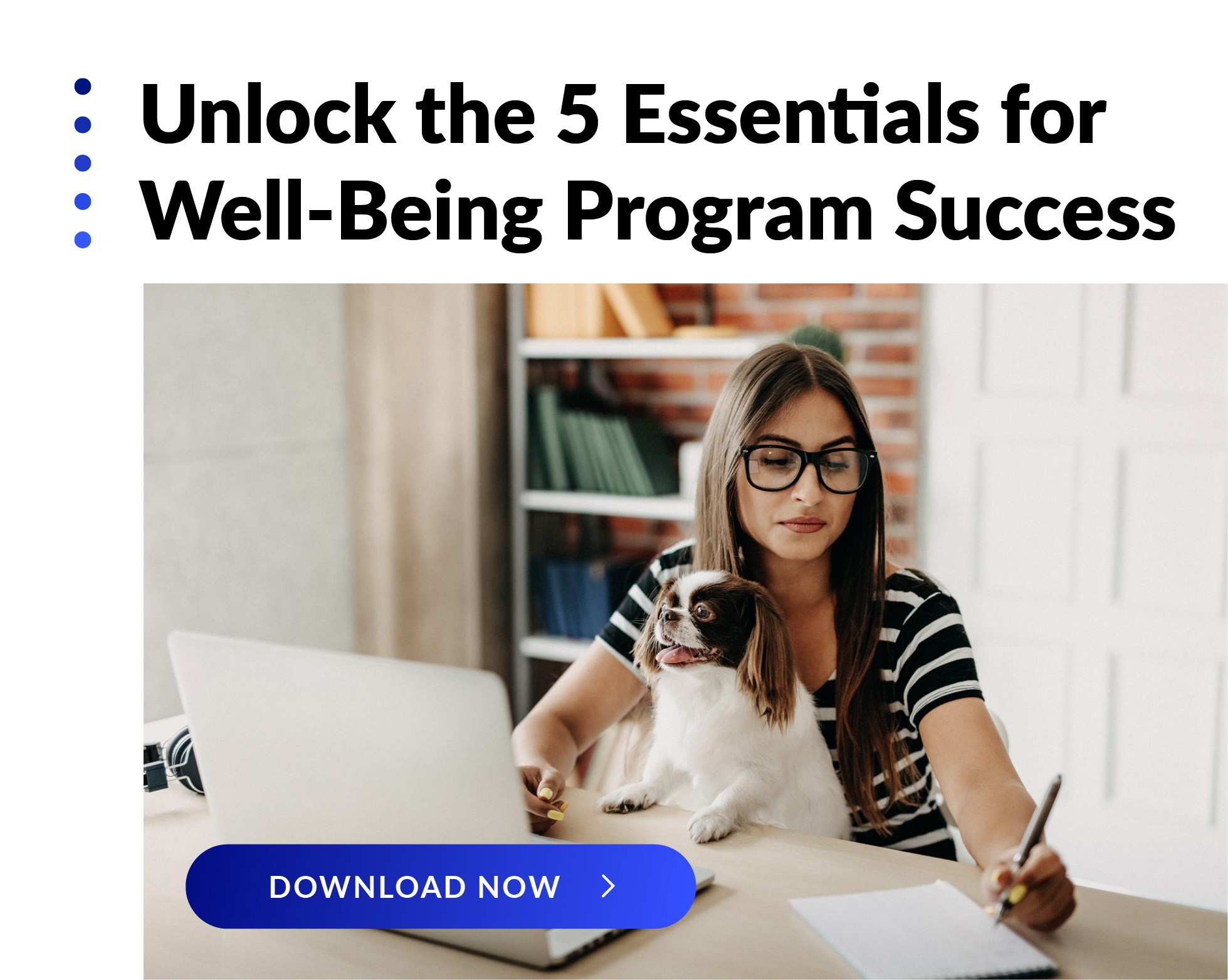
Juggling work and home life has always been a struggle. In this week’s blog, we discuss what work-life balance looks like today and eight ways employers can best support employees in finding more harmony in their lives.
Improving work-life balance seems overwhelming, even under normal circumstances. But it doesn’t have to be. Right now, more and more employers are realizing that their employees are feeling stressed, burned out, and exhausted in every aspect of their lives. And since employees spend most of their weekday working, it’s critical organizations take steps to help their employees balance their work and life again.
What is work-life balance? And is balance actually achievable?
Work-life balance means maintaining a good equilibrium between the demands of work and the demands of a personal life, which may include family, friends, hobbies, and other activities that contribute to a well-rounded existence.
But “balance” may not be the exact right word. Achieving balance implies that there is a point in time where work and life get equal attention. In reality, demands on either side tend to ebb and flow, so perhaps work-life harmony, integration, or flex are more apt terms.
The boundaries between work and life have changed dramatically over the years.
To understand how we’ve come to a place where work and life have become harder to separate, it’s helpful to think about how work has changed over the last two centuries.
During the Industrial Revolution work largely moved outside of the home and into the factory. And while the conditions and hours weren’t great, this arrangement at least afforded workers a decent separation between their job and their home life.
Even when “office work” became prevalent in the 1950s, a defined nine-to-five workday and the inability to truly take work home helped to keep this boundary largely intact. But, with the advent of the personal computer, a network connection to the office, and now the mini-computer in our pockets (our phones), there just isn’t a time or place where work cannot conceivably get done—which is a real problem for our well-being.
The pandemic threw a new wrench into the ongoing work-life struggle.
Although essential workers continued to report to a physical workplace—often at great cost to their physical and mental health—those who could work from home during the pandemic did so. Suddenly, the lack of a commute and having to “get ready” for the office freed up time for other pursuits, like exercise, hobbies, and more family time. In fact, Pew Research found that 64% of those who didn’t work from home before the pandemic said it was easier to balance work with their personal life.
But on the flip side, without a commute and an office we also lost those natural boundaries, leading to longer workdays and the feeling that we could never really disconnect from work. And, for caregivers, the concept of “more time in the day” never materialized due to childcare shortages, which persist even now. We need only look at rising rates of burnout and depression, and recent phenomena like the Great Resignation and “quiet quitting,” to appreciate that workers continue to struggle to find the right balance between work and life.
Here are eight tips employers can use to improve work-life balance for their employees:
1. Encourage company leadership to model and promote work-life balance behaviors.
As we’ve been discussing in our blogs on stress and burnout, leaders and managers set the tone for how well the organization lives into its pledge to maintain healthy work-life boundaries. Researchers from ideas42, a nonprofit that uses behavioral science to solve real world problems, noted this about leaders: “While they expressed a desire for better work-life balance — if not for themselves, at least for the rest of their staff — they were often among the worst offenders, texting at 9 PM, emailing over the weekend or at night, and rarely taking vacation.”
Does this ring true for your organization, too? Modeling appropriate work-life balance starts at the top, so urge leaders to examine the signals they might be sending to their staff members. You can even ask leaders to create visible boundaries, like blocking time for family or exercise on their calendar. Once employees see their leadership team taking time to manage their home lives, they’ll feel more empowered to make their own boundaries and begin balancing work and life.
2. Bury the “busyness culture” and share a new vision of what an ideal worker looks like for your organization.
In the U.S., we suffer from a “work first” culture which means “work is presumed to be the dominant force in our lives,” according to organizational psychologist, Adam Grant. This often translates to viewing long hours as a badge of honor or a measure of dedication to the job. Grant also notes that the perceived need to “keep monitoring our communication channels, ready to drop everything at any time” interferes with our ability to make space for leisure and rest and can contribute to work-life imbalance and burnout. This is why it’s so important for managers and co-workers alike to set and respect boundaries around response time, non-work hours, and time off.
As this Harvard Business Review article points out, perhaps it’s time to communicate that “an ideal worker in the 21st century is someone who does great work, is well-rested and healthy, and has a great life outside of work.” As a well-being organization, that is definitely a sentiment we support!
3. Ask, “Do we really need a meeting for this?”
Take a hard look at your organization’s meeting culture. If employees’ calendars are filled with back-to-back meetings, consider alternative ways to seek input or decisions. Have managers hold “office hours” so anyone can drop in and get a quick question answered. Teams could schedule Slack chats for a certain time of the day to brainstorm with co-workers. The point is to make meetings time well-spent, leaving room in the day to do focused work. That way, employees don’t feel like they must work late to catch up on projects they couldn’t work on during the day.
4. Be the company that every parent wants to work for.
One of the pandemic’s silver linings was that having a family—and being open about it to colleagues and managers—was no longer considered taboo. What a great thing for working parents! Companies began implementing free back-up childcare, company-sponsored remote learning pods, flexible work hours, sabbaticals, and extended paid family leave.
Don’t abandon these types of work-life supports even though the pandemic is over. If organizations want to keep their best employees—many of whom have children—they should maintain these safety nets to foster a better work-life balance.
5. Consider the “fake commute.”
If you work from home, gone are the days of listening to a podcast or music during your commute, which served as a healthy buffer zone before and after our busy days. Now, you start Zoom meetings shortly after waking and don’t stop until the sun has set. Some have combatted this problem by adopting a so-called “fake commute.” A short drive to grab coffee before starting work gives us some time to ease into the day; a 30-minute walk at the end of the day sends our bodies and brains the signal that it’s time to stop working.
6. Bring back the lunch hour.
Sure, some days we eat at our desks, but working in the office gives us the chance to grab a bite in the cafeteria or at a local restaurant. Make sure to take advantage of that! If you’re working from home, there’s seemingly no reason to stop working just to eat. And sometimes, we feel like we have to eat at our desks so we don’t miss any important emails.
But taking this break is essential. First, it’s a chance to give our eyes a rest from our screens. Second, it encourages us to take a break away from work to reset and recharge. Doing this can help people come back to their job feeling productive, engaged and focused. If your organization needs help convincing employees that it’s okay to step away, try mandating no meetings between 12 and 1.
7. Embrace flexibility in the workday
It’s importance to provide workplace flexibility. Allowing employees to set their own schedules can help alleviate some of the pain points of work-life integration. It enables parents to be there for school drop-off or pickup; lets caregivers attend doctor appointments; and helps employees manage a chronic condition or undergo regular medical treatments. It also allows people to work during the hours when they feel most productive. Compressed workweeks (same number of hours in a shorter time period) and four-day work weeks are more radical approaches to flexibility that are working for some organizations.
We also need to allow for more flexibility to take breaks during the workday. A team of researchers found that to build resilience at work we need to have both internal and external recovery periods. This means scheduling breaks during the workday for rejuvenating activities like walks, stretching, exercise, or meditation (internal recovery), and ensuring that employees also get enough free time at night, on weekends, and on vacation (external recovery).
8. Put supports in place to make it easier to take paid time off.
One of the reasons people cite for not taking a vacation is that it’s too stressful to make sure every aspect of work is buttoned up before leaving—not to mention the full screen of unopened emails we face when we come back. How about building in a paid transition day before and after vacation so that it’s less daunting? Or we could simply designate those buffer days as “vacation prep days,” where we don’t take meetings and block our calendars for focus time.
And at the end of the day, we all deserve a break. Just because we may not be traveling right now or taking the vacations we dream of, it’s still important to schedule time off. Even if we just lounge in our homes for a couple of days, it can do wonders for our mental health and productivity levels. So, encourage your employees to continue taking time off for rest, relaxation and self-care.
Building a Work Culture that Promotes Work-Life Integration
Of course, we’ve just scratched the surface in terms of what employers can do to inject more work-life harmony into employees’ lives. But, at its most basic, creating a work culture that fosters better integration between work and life is just about acknowledging that people are humans first, workers second.
Laura Fuentes, executive vice president and chief human resource officer at Hilton, sums it up this way: “People are looking for a human experience at work. They don’t want a work experience. They don’t want life to fit into a good job. They want work to fit into a good life.”
This sentiment can serve as a good guide as we continue to work on implementing new policies, benefits, and ways of working that foster better work-life integration and lead to healthier, happier, more productive and engaged employees.
If you’re interested in learning how to better support the well-being of your workforce, visit our website or contact us at connect@webmd.net.




